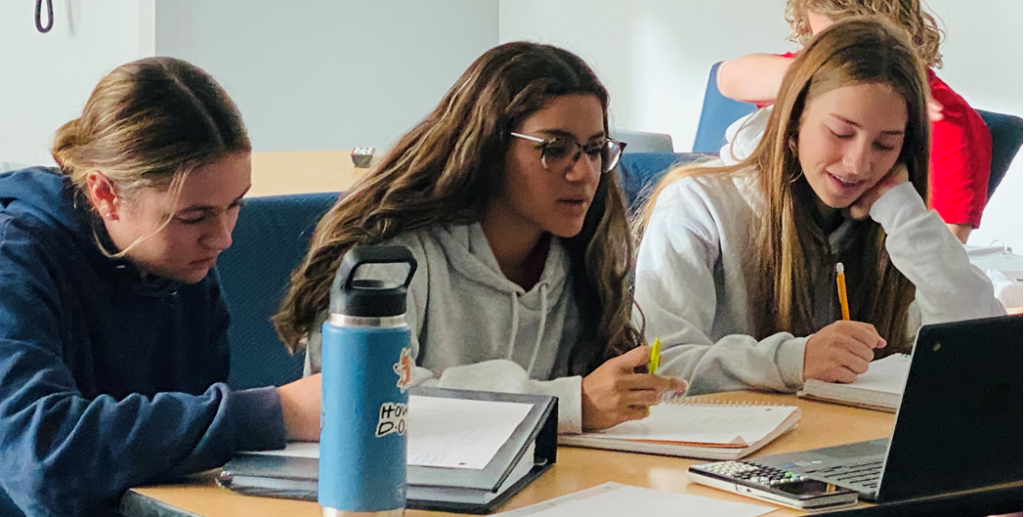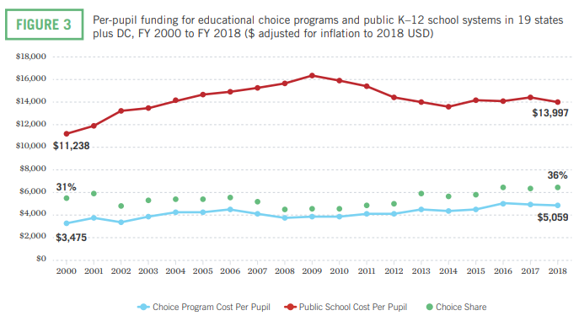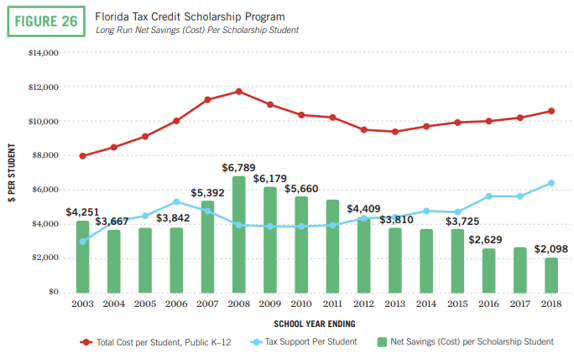
Dayspring Early College Academy, about 40 miles north of Tampa and one of a plethora of education choice options in Florida, opened this fall to 199 students and expects to grow to 300 students by 2023.
Florida’s private school choice programs have saved taxpayers more than $2.8 billion since 2000, according to new research from the national school choice advocacy group EdChoice.
Martin Leuken, director of Ed Choice’s fiscal research and education center, analyzed 40 private school scholarship programs in 19 states and Washington, D.C., for the report titled, “Fiscal Effects of School Choice.” Combined, scholarship programs in these states have saved taxpayers nearly $12.4 billion between 2000 and 2018, the last year Leuken examined.
The total cost of educating the 460,129 scholarship students in those 19 states and D.C. was just $2.4 billion, or 1% of the total cost of public education in those states.
 Savings were generated because the cost of the scholarship programs were significantly lower than that of public schools. According to the research paper, the average scholarship cost $5,059 in 2018, compared to $13,997 per pupil for the public school.
Savings were generated because the cost of the scholarship programs were significantly lower than that of public schools. According to the research paper, the average scholarship cost $5,059 in 2018, compared to $13,997 per pupil for the public school.
Florida’s estimates include the McKay Scholarship, the Florida Tax Credit Scholarship, and the Gardiner Scholarship. The Family Empowerment Scholarship, which began in 2018, is not included in the study.
The Gardiner Scholarship, now the Family Empowerment Scholarship for Students with Unique Abilities, saved taxpayers $87 million from 2014-2018.
According to EdChoice, the cost of educating a student with special needs in a Florida public school was $18,239 compared to an average cost of $10,268 for the Gardiner Scholarship.
The McKay Scholarship saved the state $2.4 billion from 2000-2018. Researchers estimate the cost of the program at $7,104 per pupil.
The Florida Tax Credit Scholarship saved the state $330 million between 2002, when the program offered its first scholarship, and 2018. The average scholarship was worth $6,465, compared to $10,610 for the per-pupil cost of a public-school student.
According to Lueken, the average scholarship in Florida was worth about 54% of what the state spent on public school students.


A recently updated report of a 2020 study that concluded public school student performance improved along with the growth of state scholarship programs for lower-income students in private schools has reaffirmed those results, going beyond the original findings.
Additional research from David Figlio, Cassandra M.D. Hart and Kryzstof Karbownik answers the question: At which level does competition matter most, district or local?
The researchers found that competition faced by the district could be even more important than the marginal degree of competition faced by the individual school, citing as an example the fact that public education choice options, such as magnet and charter schools, may have expanded more rapidly in districts that faced greater private school competition.
The original report showed that in addition to achieving better test scores, the absentee rates and number of suspensions for public school students declined. Students showing the most dramatic effects were from lower socioeconomic backgrounds. The findings ran contrary to longstanding claims from school choice opponents who claimed private school scholarship programs divert the best students from public schools and harm those left behind.
Figlio, Hart and Karbownik plan to continue exploring the subject in future versions of the study.
Their research is among many studies that demonstrate the benefits of school choice in Florida. In 2019, the left-of-center Urban Institute found that scholarship students were more likely to attend and graduate from college.
Additionally, more than a decade’s worth of evaluations, including the most recent from the Florida Learning Systems Institute, reveal that Florida’s most disadvantaged students have the same annual learning gains as all students of all income levels nationally.
Like other school choice programs where supply is overwhelmed by demand, the school district in Pinellas County, Fla. offers an option that causes plenty of joy and heartache. Some kids win the “fundamental school” lottery. Some kids lose. Some go on to the high-performing fundamentals, where they’re surrounded by peers with super-engaged parents. Others go to neighborhood schools that struggle mightily.
Are their outcomes different? Matthew Chingos, a respected researcher at the Brookings Institution, is aiming to find out.
Last week, the district agreed to give Chingos the data he requested so he could examine the impact of fundamental schools on math and reading scores. Once he gets the data, he expects to issue findings within a year, according to his research application.
His study is worth watching because it involves a school choice option offered by a school district, not by private schools or charter schools.
The fundamental schools in Pinellas stress parental involvement and student accountability. Students who fall short on academic, behavioral and dress code requirements can be reassigned to neighborhood schools. Ditto if their parents fail to meet requirements, including attending monthly meetings.
The 104,000-student Pinellas district created its first fundamental school in 1976, but expanded them rapidly in recent years. It now has more than 7,000 students in 10 full-fledged fundamental schools and two “school-within-a-school” fundamental high schools.
The schools boast some of the district’s highest test scores and lowest disciplinary rates. They also cause a fair amount of angst. (more…)